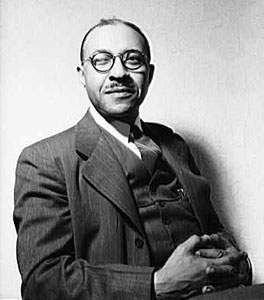
Charles S. Johnson
Charles S. Johnson, distinguished sociologist and African American leader, was born in 1893 in Bristol, Virginia. He was educated at Wayland Academy in Richmond, Virginia Union University, and the University of Chicago, where he undertook graduate work with the distinguished scholar Robert E. Park. Johnson worked with Park on The Negro in Chicago: A Study of Race Relations and a Race Riot (1922).
In 1921 Johnson moved to New York to head the Urban League. He established its journal Opportunity, and through its pages Johnson became one of the leading patrons of the Harlem Renaissance. He influenced the careers of such artists and writers as Langston Hughes, Zora Neale Hurston, Aaron Douglas, and Arnaud Bontemps.
In 1928 Johnson arrived at Fisk University to be chair of the Department of Social Sciences, which had been founded and funded by the Laura Spelman Rockefeller Memorial. With additional funds at his disposal from the Julius Rosenwald Fund, Johnson made Fisk a significant research center in race relations. Johnson and his colleagues produced several important reports documenting the many manifestations of African American economic disadvantages in the South. Their series of reports on counties and individual communities in Tennessee is an important documentary source of rural and African American life in the mid-twentieth century. His book The Negro in American Civilization (1930) became a widely accepted sociological text. His later books include Shadow of the Plantation (1934) and Growing Up in the Black Belt (1941).
During World War II Johnson openly attacked segregation for the first time. In 1943 he prepared Patterns of Negro Segregation for Gunnar Myrdal’s use in his monumental study The American Dilemma (1944). With the help of Edwin Embree, chief executive of the Rosenwald Fund, Johnson published The Monthly Summary, which provided eight thousand subscribers with the status of race relations in various parts of the country, documented by several thousand items. Beginning in 1944, also with the assistance of the Rosenwald Fund, Johnson led annual Race Relations Institutes, attended by leaders from all over the country. These meetings at Fisk University were extremely influential in the developing Civil Rights movement. While there was intense local opposition in the beginning, Ben West, then Nashville’s vice-mayor, spoke to the institute in 1949. During the 1950s Tennessee Governor Frank Clement also addressed the institute.
Johnson applauded the removal of racial barriers in various areas of society, but he, like many African American leaders, was particularly interested in ending school segregation. NAACP attorney Thurgood Marshall was a frequent speaker at Race Relations Institutes of the 1950s and Johnson provided him with evidence to use in his legal briefs for Brown v. Board of Education (1954). The failure of white moderate southerners to embrace the court’s decree quickly bitterly disappointed Johnson.
Johnson achieved the pinnacle of his academic career in 1947, when he became president of Fisk University. By the late 1940s his achievements in the worlds of education and civil rights had finally brought him recognition from various national and international organizations. He was one of ten United States delegates to UNESCO (1946-47), a member of the Fulbright Board of Foreign Scholarships (1947-54), and a delegate to the Assembly of the World Council of Churches (1948). He also advised three American presidents on educational and civil rights issues.
On October 27, 1956, Johnson died suddenly of a heart attack. World leaders mourned his passing and noted his important role in the Civil Rights movement.
Suggested Reading
Reavis L. Mitchell Jr., Fisk University Since 1866: Thy Loyal Children Make Their Way (1995); Richard Robbins, Sidelines Activist: Charles S. Johnson and the Struggle for Civil Rights (1996)



